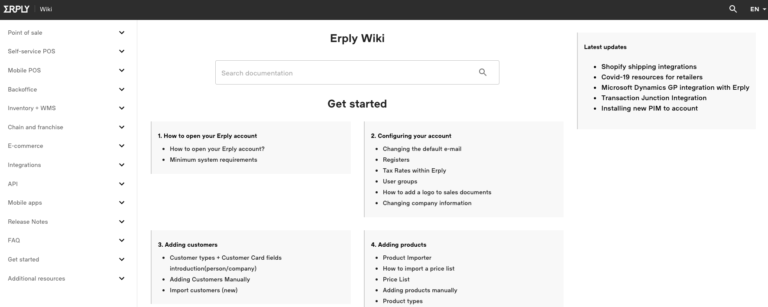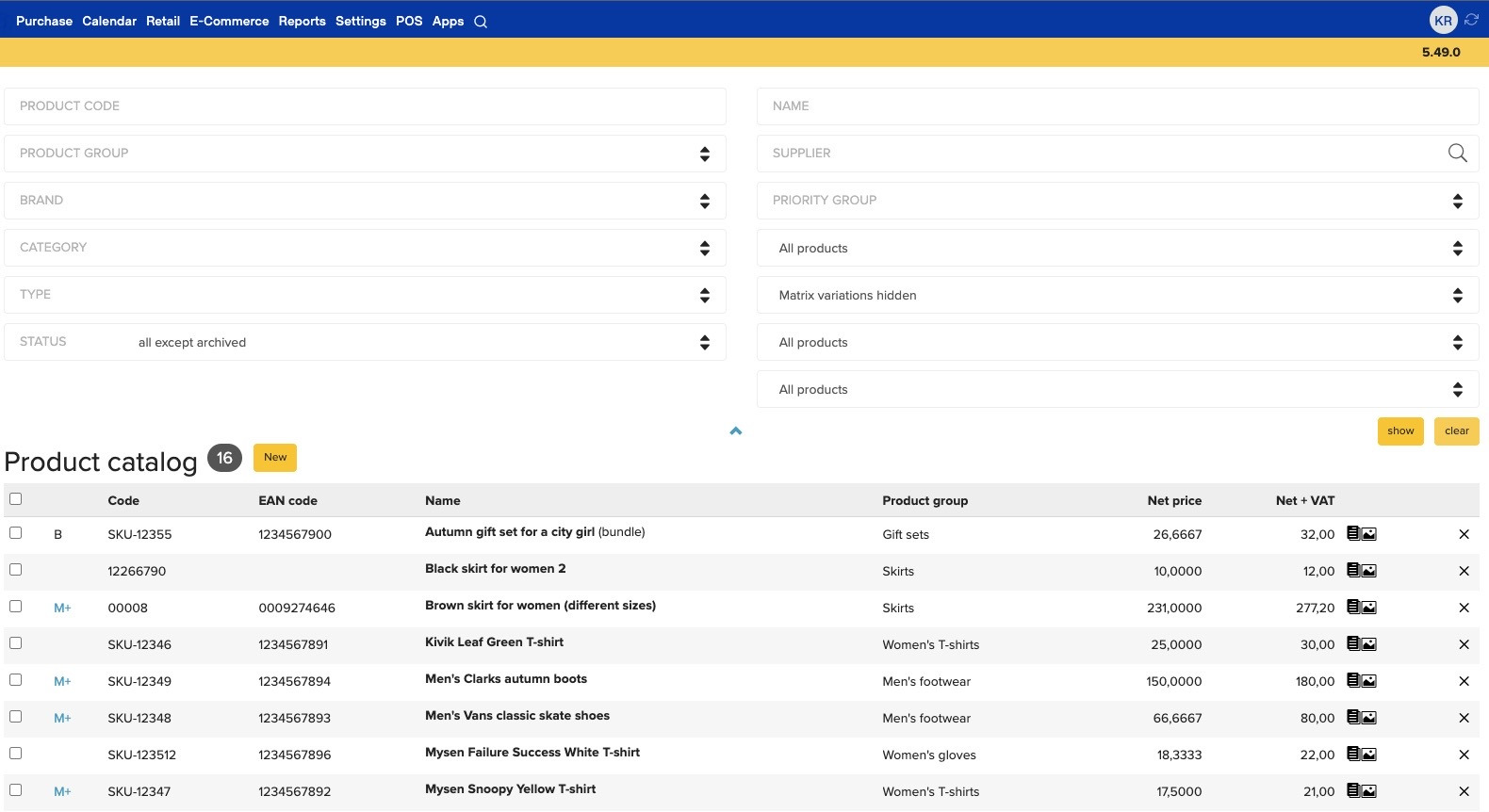Dedicated implementation manager assigned
Implementation Managers are the customer’s point person throughout ERPLY implementation. They will be the first line of contact for everything related to implementation (work-flow consulting, imports, training, GAP identification/scoping/testing etc). This role serves as the customer’s ERPLY super user until launch, when the customer should have an internal super user who has been trained by their Implementation Manager.
Data imports/migration to ERPLY (unlimited imports)
Whether transitioning from an existing software or starting brand new, one of the first steps to ERPLY implementation will be data clean up and importing. Acquiring the data necessary to import and cleaning it usually represents one of the bigger commitments for customers, but represents a valuable clean start in a new system.
There are 3 of importable data into ERPLY:
- Inventory/stock
- Suppliers
- Customers
ERPLY implementation manager will provide Excel templates with column headers defined for proper mapping to ERPLY.
Customer provides data aligned to this format as best as possible. ERPLY implementation manager can assist in aligning this data to 100% importable form, but the customer maintains responsibility for data integrity.
Upon completion of the import process, the implementation manager will review via WEBEX with the customer in the sandbox account to ensure correct mapping. Any discrepancies will be noted, and re-imports did. ERPLY will complete as many as necessary to get data aligned, and an import process solidified with the customer.
While there is no limit, pre-launch should import be a necessary business process for the customer, we will facilitate training on the tool for the customer’s own use.
Workflow consultation
Workflow consultation is the process in which the implementation manager walks through all standard processes in ERPLY. This is done on a module-by-module basis with relevant parties from the customer’s team. The purpose of this is to fit the customers’ workflows into ERPLY to ensure the best possible usage of the system, reducing work-time for inputs and maximizing output and accuracy. This consultation dovetails nicely into a GAP analysis for any areas where optimal outputs or preferences are not met. During this process, customer and implementation manager discuss the ERPLY’s standard workflows and customer’s current workflows and needs. Implementation manager identifies any advantages to utilizing ERPLY standard processes and any deficiencies. Customers often benefit from conforming to ERPLY standard flows; if this is not the case the item can be added to the GAP analysis. We typically hold this session to 1- 1.5-hour blocks, uncapped sessions. As much time is necessary inclusive, but averages 2 hours. This session typically also serves as a nice starting point for systems training.
GAP analysis
GAP analysis is tied to workflow consultation. This is the process of vetting out any customizations needed to support the customer’s specific workflows in ERPLY. This process is done via WEBEX remote meeting. Implementation manager will walk through each module in ERPLY, demonstrating the standard workflows in ERPLY, and consulting with the customer on the differences between standard and what they expect/need. Workflow analysis is done prior to this phase to ensure customer’s familiarity with the system, as well as agent’s familiarity with customer needs/processes.
GAP identification
- Customer and implementation manager to agree on what items are to be labeled as GAPS, and added to the GAP analysis document. GAPS are additions or adjustments to the system that are outside of out-of-the-box configuration or workflow.
- To provide the implementation manager a clear and concise picture of the development need items or processes identified as GAPS will be iterated within the ERPLY system with the customer present. Results including friction points and end goals will later be provided to ERPLY project team for hourly development & cost estimate.
- Once all modules are reviewed, and GAPS identified the ERPLY Implementation manager will create a GAP analysis document reflecting all items identified during the meeting. Properly identified GAPS point out the current ERPLY workflow, where the current solution is lacking, and the customer’s intended outcome. This document will be provided to the customer for review, notes and final approval before cost estimates.
- Approved and itemized GAP analysis is sent to ERPLY project team to estimate development hours per GAP item, and work with the Implementation manager to suggest non-developmental solutions. Priced developmental solutions and (usually free) non-developmental alternatives will be provided to the customer for review.
GAP item evaluation and development hours identified
- Estimate of hours/cost per item is reviewed by the customer and needs to be assessed again.
- Often, non-developmental solutions are reassessed.
GAP itemized list prioritization/delivery schedule agreed with Customer
- Implementation manager and customer to review GAP development hours, and determine phases (if applicable) to determine delivery schedule. We typically break this down into two phases: pre-launch and post-launch.
- This schedule and the launch date is confirmed and provided to the project team for development work kick-off.
Demo environment (Sandbox) creation (this is where customization releases will be installed for review/green light from Customer team)
- All GAP development items will be first released to Customer Sandbox for User Acceptance Testing and approval
- The customer is given a timeline of testing needs.
Production environment creation
- Upon successful release and approval of GAP points to Sandbox, customer production account is created.
- All GAP developments will be carried over to the production environment. This will serve as the “live” account for the customer. The Sandbox account will remain for testing, training and other purposes.
- All confirmed data imports will be transferred over from Sandbox for production
Production account set up and configuration
- Once the production account holds all customizations, and data imports it is time to do final account configuration
This includes:
- Company set up (corporate info)
- Location & register configuration
- Tax rates configuration
- User groups/User-rights configuration
- Employee/user creation
- Promotion/Price list creation (if applicable)
- Customer group creation (if applicable)
Weekly/Bi-weekly status meetings with implementation manager until launch
- To cover the steps outlined above, we provide 1x (or 2x, depending on need) weekly status meetings with the customer’s dedicated implementation manager to review status, and ensure all tasks are being complete from both ends in a timely manner • Training all staff levels (remote) 8 hrs inclusive
- Training is generally done over Webex Screen share and separated into 3 segments: Headquarters, Store Management, and Train the Trainer: POS operation. We like to keep our training sessions capped at 1 hr per session, up to 10 people, however, that is flexible upon customer request. Eight (8) hours of inclusive training can be allocated to each of the 3 training segments as the customer prefers. Implementation manager can recommend best practice.
- Headquarters training is appropriate for corporate employees who will be setting up and managing corporate data and account settings. This will encompass both the store management training, as well as the Point of sale training, and give the largest scope on the product, and confer ownership of the account. Ongoing training is available to these super users.
Store Management training is given to the Store managers/key holders. Corporate super users are asked to be in each store management training so they can assist in training during the rollout, training, and onboarding any new locations in the future, and establishing institutional memory. This training includes some account setup, user group’s rights, adding users, inventory management, and most back office functions.
Any back-office function that may need to be used by a clerk is also pushed down into the Point of Sale training, but we strive to keep most or all functionality that a clerk may need at the Point of sale, and not in the back office. o Train the Trainer: Point of Sale focuses around defining and teaching cash register activities.
The curriculum is developed in conjunction with the Headquarters Super Users, and store owners to ensure that it encompasses and roles and duties that the majority of the system users (the store employees/clerks) will need to know to operate the Point of sale system. This includes both things they need to know how to do, things they shouldn’t be able to do, and basic operational troubleshooting.
Train the Trainer: Point of Sale focuses around defining and teaching cash register activities. The curriculum is developed in conjunction with the Headquarters Super Users, and store owners to ensure that it encompasses and roles and duties that the majority of the system users (the store employees/clerks) will need to know to operate the Point of sale system. This includes both things they need to know how to do, things they shouldn’t be able to do, and basic operational troubleshooting.
Sign Up










